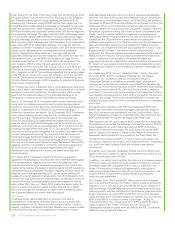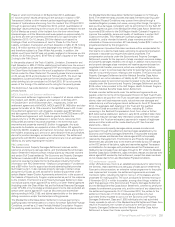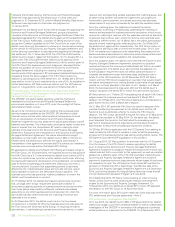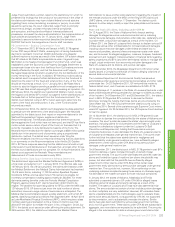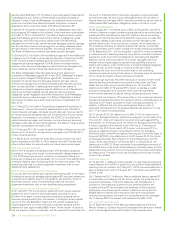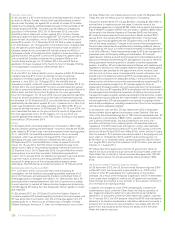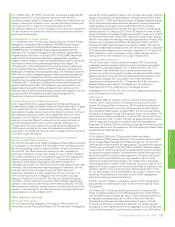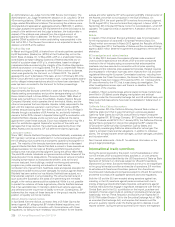BP 2014 Annual Report Download - page 244
Download and view the complete annual report
Please find page 244 of the 2014 BP annual report below. You can navigate through the pages in the report by either clicking on the pages listed below, or by using the keyword search tool below to find specific information within the annual report.
approach to corporate governance. As such, the way in which BP makes
determinations of directors’ independence differs from the NYSE rules.
BP’s board governance principles require that all non-executive directors
be determined by the board to be ‘independent in character and
judgement and free from any business or other relationship which could
materially interfere with the exercise of their judgement’. The BP board
has determined that, in its judgement, all of the non-executive directors
are independent. In doing so, however, the board did not explicitly take
into consideration the independence requirements outlined in the NYSE’s
listing standards.
Committees
BP has a number of board committees that are broadly comparable in
purpose and composition to those required by NYSE rules for domestic
US companies. For instance, BP has a chairman’s (rather than executive)
committee, nomination (rather than nominating/corporate governance)
committee and remuneration (rather than compensation) committee. BP
also has an audit committee, which NYSE rules require for both US
companies and foreign private issuers. These committees are composed
solely of non-executive directors whom the board has determined to be
independent, in the manner described above.
The BP board governance principles prescribe the composition, main
tasks and requirements of each of the committees (see the board
committee reports on page 64). BP has not, therefore, adopted separate
charters for each committee.
Under US securities law and the listing standards of the NYSE, BP is
required to have an audit committee that satisfies the requirements of
Rule 10A-3 under the Exchange Act and Section 303A.06 of the NYSE
Listed Company Manual. BP’s audit committee complies with these
requirements. The BP audit committee does not have direct
responsibility for the appointment, re-appointment or removal of the
independent auditors – instead, it follows the UK Companies Act 2006 by
making recommendations to the board on these matters for it to put
forward for shareholder approval at the AGM.
One of the NYSE’s additional requirements for the audit committee
states that at least one member of the audit committee is to have
‘accounting or related financial management expertise’. The board
determined that Brendan Nelson possessed such expertise and also
possesses the financial and audit committee experiences set forth in
both the UK Corporate Governance Code and SEC rules (see Audit
committee report on page 64). Mr Nelson is the audit committee financial
expert as defined in Item 16A of Form 20-F.
Shareholder approval of equity compensation plans
The NYSE rules for US companies require that shareholders must be
given the opportunity to vote on all equity-compensation plans and
material revisions to those plans. BP complies with UK requirements that
are similar to the NYSE rules. The board, however, does not explicitly
take into consideration the NYSE’s detailed definition of what are
considered ‘material revisions’.
Code of ethics
The NYSE rules require that US companies adopt and disclose a code of
business conduct and ethics for directors, officers and employees. BP
has adopted a code of conduct, which applies to all employees, and has
board governance principles that address the conduct of directors. In
addition BP has adopted a code of ethics for senior financial officers as
required by the SEC. BP considers that these codes and policies address
the matters specified in the NYSE rules for US companies.
Code of ethics
The company has adopted a code of ethics for its group chief executive,
chief financial officer, group controller, general auditor and chief
accounting officer as required by the provisions of Section 406 of the
Sarbanes-Oxley Act of 2002 and the rules issued by the SEC. There have
been no waivers from the code of ethics relating to any officers.
BP also has a code of conduct, which is applicable to all employees,
officers and members of the board. This was updated (and published) in
July 2014.
Controls and procedures
Evaluation of disclosure controls and procedures
The company maintains ‘disclosure controls and procedures’, as such
term is defined in Exchange Act Rule 13a-15(e), that are designed to
ensure that information required to be disclosed in reports the company
files or submits under the Exchange Act is recorded, processed,
summarized and reported within the time periods specified in the
Securities and Exchange Commission rules and forms, and that such
information is accumulated and communicated to management, including
the company’s group chief executive and chief financial officer, as
appropriate, to allow timely decisions regarding required disclosure.
In designing and evaluating our disclosure controls and procedures, our
management, including the group chief executive and chief financial
officer, recognize that any controls and procedures, no matter how well
designed and operated, can provide only reasonable, not absolute,
assurance that the objectives of the disclosure controls and procedures
are met. Because of the inherent limitations in all control systems, no
evaluation of controls can provide absolute assurance that all control
issues and instances of fraud, if any, within the company have been
detected. Further, in the design and evaluation of our disclosure controls
and procedures our management necessarily was required to apply its
judgement in evaluating the cost-benefit relationship of possible controls
and procedures. Also, we have investments in certain unconsolidated
entities. As we do not control these entities, our disclosure controls and
procedures with respect to such entities are necessarily substantially
more limited than those we maintain with respect to our consolidated
subsidiaries. Because of the inherent limitations in a cost-effective
control system, misstatements due to error or fraud may occur and not
be detected. The company’s disclosure controls and procedures have
been designed to meet, and management believes that they meet,
reasonable assurance standards.
The company’s management, with the participation of the company’s
group chief executive and chief financial officer, has evaluated the
effectiveness of the company’s disclosure controls and procedures
pursuant to Exchange Act Rule 13a-15(b) as of the end of the period
covered by this annual report. Based on that evaluation, the group chief
executive and chief financial officer have concluded that the company’s
disclosure controls and procedures were effective at a reasonable
assurance level.
Management’s report on internal control over financial
reporting
Management of BP is responsible for establishing and maintaining
adequate internal control over financial reporting. BP’s internal control
over financial reporting is a process designed under the supervision of
the principal executive and financial officers to provide reasonable
assurance regarding the reliability of financial reporting and the
preparation of BP’s financial statements for external reporting purposes
in accordance with IFRS.
As of the end of the 2014 fiscal year, management conducted an
assessment of the effectiveness of internal control over financial
reporting in accordance with the Internal Control Revised Guidance for
Directors (Turnbull). Based on this assessment, management has
determined that BP’s internal control over financial reporting as of
31 December 2014 was effective.
The company’s internal control over financial reporting includes policies
and procedures that pertain to the maintenance of records that, in
reasonable detail, accurately and fairly reflect transactions and
dispositions of assets; provide reasonable assurances that transactions
are recorded as necessary to permit preparation of financial statements in
accordance with IFRS and that receipts and expenditures are being made
only in accordance with authorizations of management and the directors
of BP; and provide reasonable assurance regarding prevention or timely
detection of unauthorized acquisition, use or disposition of BP’s assets
that could have a material effect on our financial statements. BP’s
internal control over financial reporting as of 31 December 2014 has been
audited by Ernst & Young, an independent registered public accounting
firm, as stated in their report appearing on page 95 of BP Annual Report
and Form 20-F 2014.
240 BP Annual Report and Form 20-F 2014


